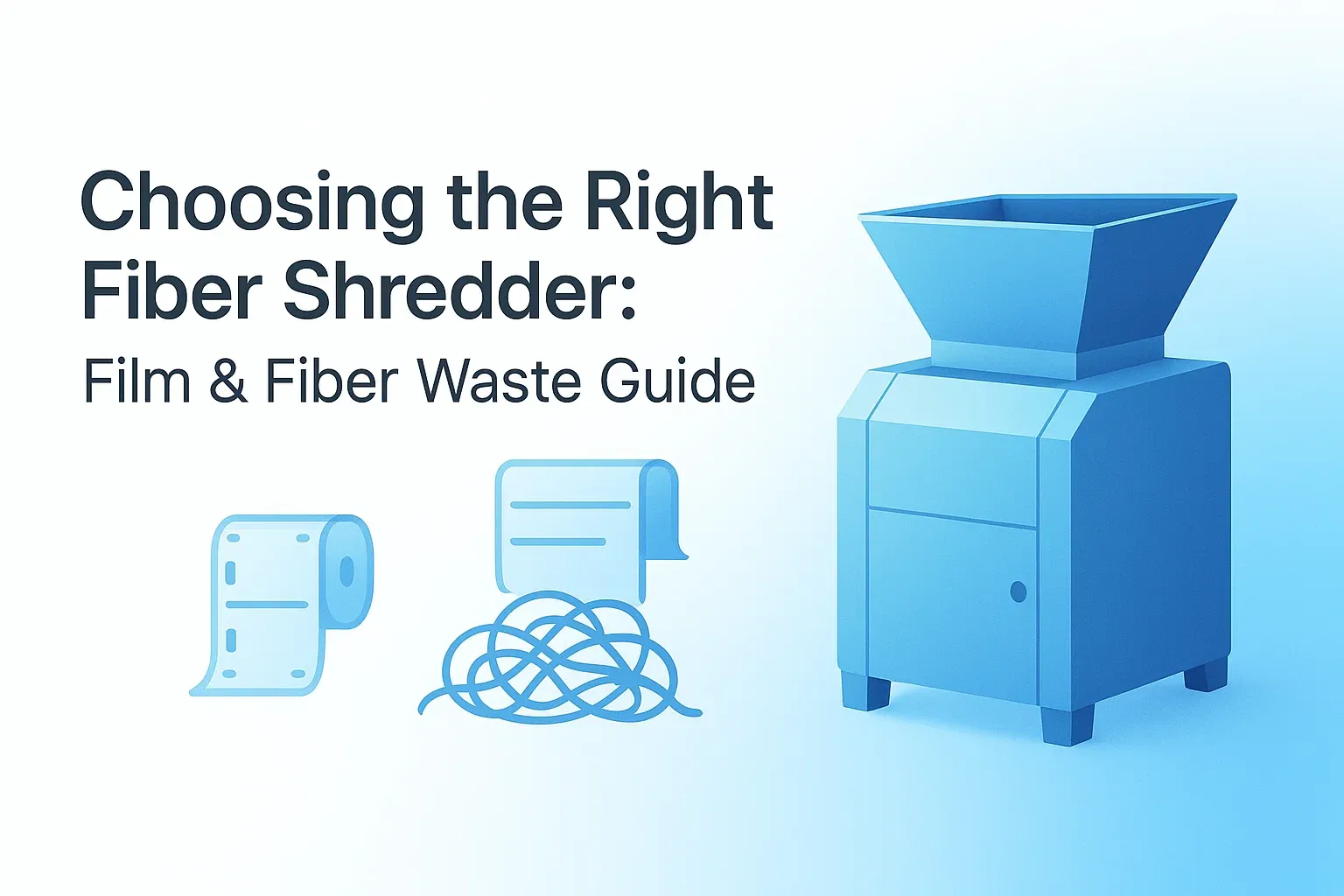Esplorare il mondo dei trituratori industriali alla ricerca della soluzione ideale per i vostri scarti di film e fibre può sembrare complicato. Con una moltitudine di opzioni disponibili, individuare la soluzione giusta trituratore di fibre è fondamentale per una gestione efficiente ed economica dei rifiuti. Questa guida è pensata per semplificare questo processo, offrendo consigli pratici e approfondimenti per aiutarvi a scegliere l'attrezzatura di triturazione più adatta alle vostre esigenze operative. Approfondiremo fattori critici come le caratteristiche dei materiali, il volume di lavorazione e l'uniformità di produzione desiderata, oltre a dare un'occhiata a ciò che distingue determinati marchi e modelli.
Comprendere i requisiti specifici di triturazione
Prima di addentrarci nelle specifiche dei macchinari, il primo passo essenziale è una valutazione approfondita del flusso dei propri rifiuti e degli obiettivi di lavorazione.
Tipo di materiale: non tutte le pellicole e le fibre sono uguali
Comprendere la natura precisa dei materiali che devi triturare è fondamentale per scegliere un metodo efficace trituratore di fibre.
- Rifiuti di pellicola: Questa categoria include spesso materiali come sacchetti di plastica, pellicole termoretraibili, pellicole agricole e imballaggi flessibili. Questi materiali, sebbene apparentemente leggeri, possono presentare difficoltà come l'aggrovigliamento attorno agli alberi del trituratore o la necessità di meccanismi di taglio specifici per evitare allungamenti e garantire un taglio netto. Un trituratore adatto dovrà essere in grado di afferrare e processare efficacemente questi materiali leggeri e flessibili.
- Rifiuti di fibre: Questa ampia categoria comprende una vasta gamma di materiali, tra cui:
- Tessili: Vestiti, rivestimenti, tappeti e scarti di produzione post-consumo, come la cimosa.
- Materiali fibrosi industriali: Corde, reti (reti da pesca, reti agricole), fibra di vetro, fibra di carbonio (che richiede l'uso di trituratori specializzati per impieghi gravosi), fibre sintetiche e fibre naturali come cotone, juta o scarti di canapa. Questi materiali richiedono spesso materiali robusti. trituratore di fibre design grazie alla loro robustezza, abrasività e tendenza ad avvolgersi attorno alle parti mobili.
Volume di elaborazione: quanto devi triturare?
Il volume di rifiuti generati influenzerà direttamente le dimensioni richieste, la capacità di produzione e la robustezza complessiva del tuo trituratore di fibre.
- Basso volume: Ideale per piccole imprese, progetti pilota o attività con esigenze di distruzione intermittenti. Possono essere sufficienti modelli compatti e meno potenti.
- Volume medio: Adatti alla distruzione quotidiana e regolare in impianti di produzione di medie dimensioni o centri di riciclaggio, questi distruggidocumenti offrono un equilibrio perfetto tra capacità e ingombro.
- Alto volume: Necessario per operazioni industriali su larga scala, impianti di riciclaggio municipali o processi di lavorazione continua 24 ore su 24, 7 giorni su 7. Questi richiedono prestazioni elevate. trituratori di fibre con elevata produttività e durata.
Risultato desiderato: a cosa servirà il materiale triturato?
L'utilizzo finale del materiale triturato determina la granulometria e l'uniformità richieste. Questo è un fattore critico nella configurazione del tuo trituratore di fibre.
- Dimensioni uniformi: Essenziale per molti processi di riciclo, ad esempio quando le fibre triturate devono essere rifilate, utilizzate come riempitivo o densificate. Una pezzatura uniforme migliora la qualità e la fruibilità del prodotto riciclato.
- Particelle fini/Lunghezza delle fibre corte: Richiesto per applicazioni quali la pellettizzazione, la miscelazione, la produzione di materiali non tessuti o la creazione di prodotti riciclati di alta qualità in cui è necessario un materiale più piccolo e omogeneo.
- Filamenti grossolani/fibre più lunghe: Accettabile per la riduzione del volume prima dello smaltimento in discarica, dell'incenerimento con recupero di energia o per applicazioni di riciclaggio meno impegnative in cui la dimensione precisa delle particelle non è fondamentale.
Fattori chiave da considerare quando si sceglie un trituratore di fibre
Una volta che hai un quadro chiaro delle tue esigenze, puoi iniziare a valutare gli aspetti tecnici dei diversi distruggidocumenti.
Tipo di trituratore: adattamento della macchina alla missione
Diversi modelli di trituratori si adattano a materiali e requisiti di produzione diversi. Per la pellicola, e in particolare per la fibra, alcuni tipi sono più diffusi:
- Trituratori monoalbero: Altamente versatili e ampiamente utilizzati per una varietà di materiali, tra cui fibre e film. Utilizzano un rotore ad alta velocità con più coltelli di taglio che lavorano contro lame fisse. Un cilindro idraulico spinge il materiale verso il rotore, garantendo un'alimentazione uniforme. La granulometria in uscita è controllata da un vaglio, rendendoli eccellenti per applicazioni che richiedono una granulometria specifica per trituratore di fibre applicazioni.
- Trituratori a doppio albero (trituratori a taglio): Si tratta di strumenti robusti e affidabili, ideali per applicazioni gravose e per la lavorazione di materiali resistenti, voluminosi o difficili da triturare, come tessuti densi, corde e alcune fibre industriali. Sono dotati di due alberi controrotanti con dischi di taglio a uncino che si ingranano tra loro per afferrare, strappare e tranciare il materiale. Pur essendo eccellenti per la riduzione primaria delle dimensioni, generalmente producono una granulometria meno uniforme rispetto ai trituratori monoalbero, a meno che non vengano abbinati a una lavorazione secondaria.
- Trituratori a quattro alberi: Combinano la triturazione aggressiva dei modelli a doppio albero con il controllo dimensionale di un vaglio, offrendo un output più uniforme in un'unica passata. Sono particolarmente efficaci per materiali complessi e possono essere una buona scelta per alcuni trituratore di fibre compiti che richiedono una geometria delle particelle coerente.
- Granulatori: Tipicamente utilizzati come trituratori secondari dopo un primario trituratore di fibreI granulatori raffinano il materiale triturato in granuli piccoli e uniformi o particelle fini. Sono essenziali se si necessita di una produzione molto ridotta e costante, soprattutto per la lavorazione di materie plastiche e alcune applicazioni di fibre che richiedono la pellettizzazione.
Potenza, prestazioni ed efficienza
Il cuore di qualsiasi trituratore di fibre è il suo sistema di azionamento e la camera di taglio.
- Potenza del motore (kW/CV): Assicuratevi che il trituratore abbia una potenza del motore sufficiente (kilowatt o cavalli vapore) per gestire i materiali più difficili presenti nel flusso di rifiuti e per raggiungere la produttività desiderata. Trituratori sottodimensionati avranno difficoltà, con conseguente riduzione dell'efficienza e potenziali danni.
- Progettazione della camera di taglio: Per le fibre, cercate caratteristiche che ne impediscano l'avvolgimento, come rotori dal design specifico, lame opportunamente distanziate e meccanismi di pulizia efficaci. Anche il materiale e la geometria delle lame sono fondamentali per tagliare efficacemente le fibre, evitandone la lacerazione.
- Efficienza energetica: I moderni trituratori spesso incorporano funzionalità di risparmio energetico, come controlli intelligenti, motori efficienti e meccanismi di taglio ottimizzati, per ridurre i costi operativi, un fattore significativo nelle operazioni ad alto volume.
Manutenzione, durata e durata
La triturazione, soprattutto di fibre abrasive, è un processo impegnativo.
- Facilità di manutenzione: Scegliete modelli che offrano facile accesso a componenti critici come lame/frese, filtri e cuscinetti per ispezioni, pulizie e sostituzioni di routine. I sistemi di cambio rapido delle lame possono ridurre significativamente i tempi di fermo macchina.
- Durata e qualità costruttiva: Optate per una struttura robusta, utilizzando materiali di alta qualità e resistenti all'usura per la camera di taglio, gli alberi e i coltelli. Questo è particolarmente importante quando si lavorano materiali abrasivi come la fibra di vetro o tessuti fortemente contaminati, per garantire affidabilità a lungo termine e ridurre al minimo i costi legati all'usura. Rotori con superficie dura e coltelli con trattamento speciale sono spesso consigliati per trituratore di fibre applicazioni.
Marchi affidabili e considerazioni per i modelli
Sebbene le raccomandazioni specifiche sui modelli dipendano fortemente dalle esigenze individuali, alcuni marchi sono molto apprezzati nel settore per la loro trituratore di fibre e soluzioni per la triturazione di pellicole. Quando valutate le opzioni, considerate marchi noti per:
- Vecoplan: Spesso riconosciuti per i loro innovativi trituratori monoalbero, altamente configurabili con diversi rotori, lame e dimensioni del setaccio, rendendoli adatti a diverse applicazioni con fibre e film. La loro serie VAZ, ad esempio, è nota per la sua versatilità.
- RUMTOO: Molti produttori offrono un'ampia gamma di trituratori, inclusi modelli monoalbero e bialbero adatti a diverse scale operative. Cercate chi può dimostrare esperienza con materiali simili ai vostri.
- Sistemi di triturazione SSI: Rinomati per i loro trituratori per impieghi gravosi, in particolare i modelli a doppio taglio come la serie Dual-Shear® M, progettati per materiali resistenti e voluminosi e possono essere efficaci anche per balle di fibre dense o altre materie prime difficili.
Quando valuti modelli specifici, informati sulle caratteristiche pertinenti alle tue esigenze:
- Può il trituratore di fibre gestire in modo efficace i tipi specifici di fibre che lavori senza avvolgerle eccessivamente o usurarle prematuramente?
- Quali dimensioni di setaccio o configurazioni di taglio sono disponibili per ottenere le dimensioni desiderate delle particelle in uscita?
- Il produttore offre la possibilità di effettuare test con i vostri materiali specifici?
Conclusione: fare una scelta consapevole del distruggidocumenti
Scegliere il giusto trituratore di fibre Per i vostri scarti di film e fibre, un investimento fondamentale può avere un impatto significativo sulla vostra efficienza operativa, sul successo del riciclo e sui profitti. Analizzando attentamente il tipo di materiale, il volume e la produttività desiderata, e comprendendo le caratteristiche principali e le tipologie di trituratori disponibili, potrete prendere una decisione consapevole.
Non esitate a consultare i produttori di trituratori, discutere le vostre sfide specifiche e persino richiedere prove sui materiali. Un approccio approfondito vi garantirà di selezionare un trituratore di fibre che non solo soddisfa le tue esigenze attuali, ma rappresenta anche una risorsa affidabile per gli anni a venire, trasformando i tuoi rifiuti in una risorsa preziosa.



